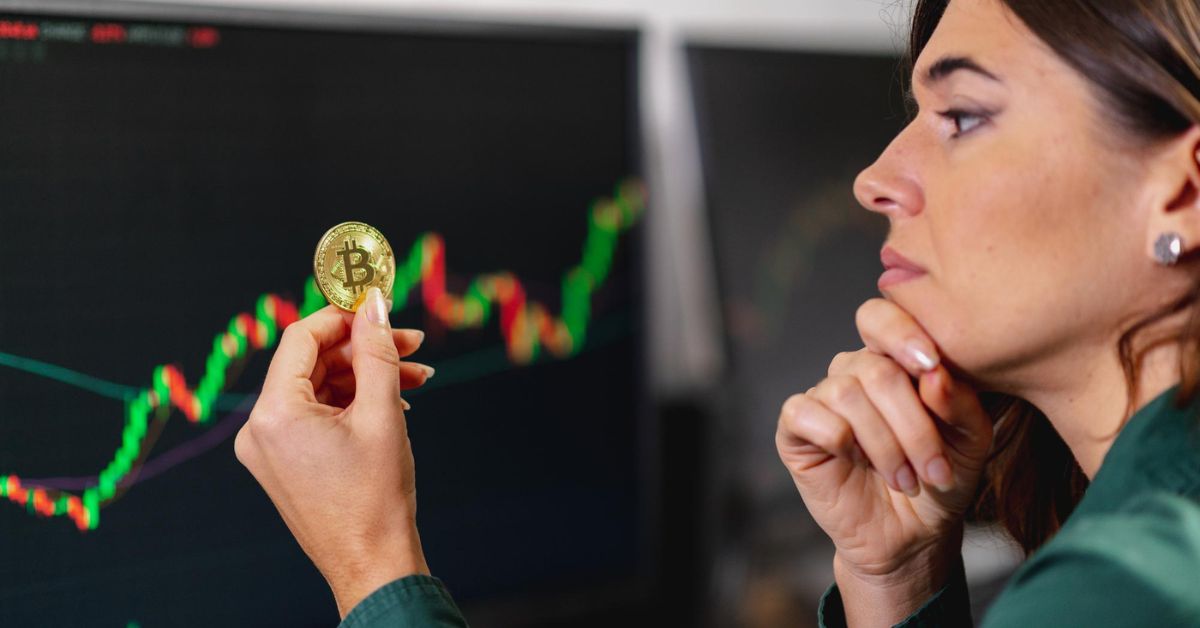Bitcoin trading offers great opportunities, but it also comes with significant risks. The crypto market is known for its high volatility, meaning prices can change rapidly. Without proper Bitcoin risk management, traders can face substantial losses. This is where platforms like Prime XBT come in. Prime XBT provides a reliable and user-friendly trading environment.
It offers various tools and resources to help traders manage risks effectively. It provides advanced charts, real-time data, and risk management options that make crypto trading more confident and easier. So, join PrimeXBT today! Use promo code PRIMEOTT to receive a +7% bonus on your deposit.
Whether you are a beginner or experienced, knowing how to protect your investments is key. In this article, we’ll explore how Bitcoin risk management can help you minimize losses and maximize your chances of success. Let’s get started.
What are the Bitcoin Trading Risks?

Bitcoin trading offers high rewards but also comes with significant risks. The primary risks involved in Bitcoin trading include market risk, liquidity risk, and cybersecurity threats.
Market Risk
Market risk refers to the potential for financial loss due to price volatility. Bitcoin, like other cryptocurrencies, is known for its unpredictable price swings. In fact, Bitcoin has experienced fluctuations of over 10% in a single day on several occasions.
University of Cambridge researchers found that Bitcoin’s annualized volatility often exceeded 100%, much higher than that of stocks or bonds. This makes Bitcoin trading particularly risky for those who are not prepared to handle such volatility.
Liquidity Risk
Liquidity risk involves the difficulty of buying or selling Bitcoin at a desired price due to insufficient market activity. In a market with low liquidity, it can be hard to execute trades without affecting the market price.
In some cases, traders may not be able to exit a position at the price they want, leading to losses. The liquidity risk is especially high during periods of market uncertainty, such as during sudden crashes.
Cybersecurity Threats
Cybersecurity is another critical risk in Bitcoin trading. With the rise of cryptocurrency, hacking attempts and fraud have also increased. In fact, in 2020, over $1.9 billion worth of crypto was stolen due to cyberattacks, according to a report by CipherTrace. Traders who do not secure their private keys or use unreliable platforms are at a higher risk of losing their Bitcoin holdings.
Bitcoin Risk Management Strategies for Traders

When trading Bitcoin, effective risk management strategies are crucial to minimize losses and maximize potential profits. Due to Bitcoin’s volatility, even experienced traders can face significant risks. Implementing a well-established strategy can help traders navigate these risks more confidently. Here are some key risk management strategies for Bitcoin traders:
Portfolio Diversification
Diversifying your Bitcoin holdings with other cryptocurrencies or traditional assets is one of the most effective ways to mitigate risk. If you spread your investments across different assets, Bitcoin’s price fluctuations won’t affect your portfolio too much. In case Bitcoin faces a downturn, other assets may not be as affected, providing a buffer.
For example, holding a mix of Bitcoin and Ethereum can lower the risk of being too exposed to Bitcoin’s volatility. Ethereum generally behaves differently in market movements, which provides a hedge. Some traders even go a step further by including stocks, bonds, or real estate in their portfolios to balance their investments further.
Additionally, using crypto index funds or ETFs (exchange-traded funds) is another way to diversify. These funds allow traders to invest in a basket of cryptocurrencies rather than just one, further reducing individual asset risk. In a 2022 report by the Financial Times, institutional investors are increasingly using crypto ETFs to diversify their portfolios.
Setting Stop-Loss Orders
Stop-loss orders are one of the most widely used tools for managing risk in Bitcoin trading. A stop-loss order automatically sells your Bitcoin at a predetermined price to limit potential losses.
Stop-loss orders prevent your losses from spiraling out of control during a price drop. Our On Tilt Trading Store offers an advanced stop-loss calculator that helps you maximize profits and manage risk based on market data.
For instance, if Bitcoin is trading at $50,000, you might set a stop-loss order at $48,000. If the price of Bitcoin falls to $48,000, the stop-loss will automatically trigger, preventing further losses. This can be especially helpful during times of high volatility when Bitcoin’s price can drop quickly.
To effectively set a stop-loss order, you need to understand market trends and set an appropriate threshold. A well-set stop-loss will allow you to avoid significant losses while giving your trades enough room to move in your favor.
Utilizing Risk-Reward Ratios
Before entering any Bitcoin trade, it’s essential to assess the potential risk and reward. A risk-reward ratio helps you measure the possible returns of a trade against the possible losses. For example, if you’re willing to risk $500 on a trade, but the potential reward is $1,500, the risk-reward ratio is 1:3.
This means you expect three times the potential reward for every unit of risk. A general rule of thumb is to look for trades where the reward is at least twice the risk (2:1 ratio). This way, even if a few trades result in losses, your profitable trades will offset them.
Hedging and Using Derivatives
Hedging is a strategy used to protect against potential price declines. For Bitcoin traders, this can involve safeguarding their positions using Bitcoin futures or options contracts. Futures contracts allow traders to lock in a price for Bitcoin at a future date, offering protection against sudden market drops.
For example, if you own Bitcoin and are concerned about a potential market downturn, you might buy a Bitcoin futures contract. Your Bitcoin holdings will lose value if Bitcoin falls, but the profit from future contracts will offset it. Similarly, options contracts give traders the right (but not the obligation) to buy or sell Bitcoin at a specified price.
While these strategies can be effective, they require an understanding of derivatives markets and can be complex for beginners.
Importance of Cybersecurity in Bitcoin Risk Management

Bitcoin has become a popular trading asset, but it also attracts significant risks from cyber threats. Let’s explore the common cybersecurity threats and how to safeguard your Bitcoin effectively.
Phishing Attacks
Phishing involves cybercriminals tricking you into revealing sensitive information, such as passwords, private keys, or wallet recovery phrases. These attacks are usually conducted through emails or fake websites that look similar to trusted platforms. In 2021, over 5% of all reported cryptocurrency-related scams were phishing attacks.
Bitcoin traders should always double-check the URLs and never click on suspicious links or emails. This can help them avoid falling victim to scams that aim to steal sensitive information.
Malware and Ransomware
Malware refers to malicious software that can infect your devices and steal your private information, including Bitcoin keys. Ransomware, a type of malware, locks users out of their files or systems until they pay a ransom.
A report by Kaspersky in 2022 showed that over 6.5 million pieces of malware targeting cryptocurrency users were detected globally. As a Bitcoin trader, it’s vital to use up-to-date antivirus software and avoid downloading software from unreliable sources.
Exchange Hacks
Hackers often target cryptocurrency exchanges where large amounts of Bitcoin and other assets are stored. In some cases, hackers have successfully infiltrated exchanges and stolen millions of dollars worth of Bitcoin. For example, the infamous Mt. Gox hack resulted in the loss of 850,000 Bitcoins.
To reduce this risk, consider using exchanges that have strong security protocols and a history of protecting user funds. Also, limit the amount of Bitcoin you store on exchanges and consider using private wallets for long-term holdings.
How to Secure Digital Assets

Following are some ways to safeguard your digital assets, such as Bitcoin.
Hardware Wallets
A hardware wallet is one of the safest methods for securing Bitcoin. These physical devices store your private keys offline, making them resistant to online threats. Since they are not connected to the internet, hackers cannot remotely access them.
A survey by Cointelegraph in 2022 confirmed that hardware wallets are one of the most secure ways to store cryptocurrency. Compared to software wallets, they provide an extra layer of protection.
If you want a hardware wallet that will secure your crypto and digital assets, consider Ledger Wallets. The company’s hardware is multi-currency wallets that store private keys for cryptocurrencies offline in cold storage.
Two-Factor Authentication (2FA)
Two-factor authentication (2FA) adds an extra layer of protection by requiring two forms of verification before granting access to your account. It usually involves a password and a second factor, like a code sent to your mobile phone.
Many trading platforms, including Binance, Prime XBT, and Kraken, offer 2FA. Enabling 2FA can significantly reduce the risk of unauthorized access to your accounts.
Keep Software Up-to-Date
Keeping your software and applications updated ensures that any security vulnerabilities are patched. Hackers often target outdated software, as it may contain flaws that they can exploit.
A 2021 Bitdefender report found a significant percentage of security breaches in the cryptocurrency world were due to outdated software. Regularly updating your operating system, crypto wallets, and apps can help protect you from these types of attacks.
Adapting to Regulatory Changes in Bitcoin Trading
The landscape of cryptocurrency trading, including Bitcoin, is shaped by ever-evolving regulations worldwide. As governments and regulators continue to develop policies for cryptocurrencies, Bitcoin traders must stay alert. Regulatory changes can significantly impact Bitcoin’s market price and availability.
The Significance of Regulatory Changes
Regulatory shifts can affect Bitcoin’s value and the trading environment. For instance, when countries like China imposed restrictions on Bitcoin mining and trading in 2021, the price of Bitcoin dropped sharply.
Alternatively, when favorable regulations are introduced in places like the U.S. or the EU, Bitcoin prices can go up. Bitcoin’s volatility often stems from regulatory uncertainty. In 2022, the Cambridge Centre for Alternative Finance report found that 30% of Bitcoin’s price fluctuations stem from regulatory news.
The Impact on Market Price and Availability
Regulatory changes can influence Bitcoin’s availability on exchanges and platforms. If a country bans or restricts Bitcoin trading, it could lower liquidity or limit trading options in that region. In contrast, countries that adopt Bitcoin as legal tender, like El Salvador, can lead to more adoption and demand for it.
An example of this is when the U.S. Securities and Exchange Commission (SEC) began scrutinizing cryptocurrency exchanges more heavily in 2022. This prompted some platforms to withdraw from the market, affecting Bitcoin’s availability for traders in certain regions. However, some regulatory clarity can create an environment where Bitcoin thrives, offering more accessible trading opportunities.
Staying Updated on Regulatory Trends
To adapt effectively, Bitcoin traders need to stay informed about both local and global regulatory trends. Regulatory bodies are increasingly developing frameworks for cryptocurrencies, which can have direct consequences on trading strategies. For example, the European Union introduced the Markets in Crypto-Assets (MiCA) regulation in 2023 to bring more clarity to the crypto industry.
Traders should follow news from trusted financial regulators like the SEC (U.S.), FCA (U.K.), and the European Central Bank. Additionally, it’s crucial to monitor updates from crypto exchanges, which often adjust policies in response to regulatory changes.
Managing Psychological Risks in Bitcoin Trading

In Bitcoin trading, emotions like fear and greed can lead to poor decisions. For example, fear can make a trader sell too soon during a market dip, while greed can make them take big risks. These emotional decisions can lead to significant losses.
The Impact of Fear and Greed
Fear may make you panic sell, thinking the market will crash, only to miss out on gains when the price recovers. Greed, on the other hand, can lead to risky trades in search of large profits. These emotions can cloud judgment and lead to mistakes.
Staying Disciplined
To avoid emotional mistakes, it’s important to stick to a plan. First, set clear goals for what you want to achieve. Next, make a trading plan with rules on when to buy or sell. This helps you focus on your long-term goals instead of reacting to short-term market changes.
Lastly, avoid rushing into trades. Take your time, follow your plan, and stay patient. This strategy has been shown to improve trading success over time.
Using Fundamental and Technical Analysis in Bitcoin Trading
Fundamental and technical analysis are essential tools in Bitcoin trading. They can help reduce risk and inform better trading decisions. Market data, charts, and news can also help traders predict Bitcoin’s price trends. Together, these methods give traders a clearer picture of when to buy, sell, or hold.
What is Fundamental Analysis?
Fundamental analysis focuses on understanding Bitcoin’s value based on external factors, such as news, market sentiment, and economic events. For example, changes in government regulations or large institutional investments can affect Bitcoin’s price.
According to a 2023 study, Bitcoin’s price is heavily influenced by news events like ETF approvals and global financial crises. Monitoring such events can help predict potential price movements.
What is Technical Analysis?
Technical analysis uses past market data, mainly price and volume, to predict future price movements. Traders use charts to identify trends and patterns, such as support and resistance levels.
For instance, the moving average is a common technical tool that helps smooth out price action and signal potential market trends. Approximately 70% of traders rely on technical analysis for short-term trading decisions.
Combining Both Approaches
The best traders often combine fundamental and technical analysis. If fundamental news shows Bitcoin’s adoption is growing, technical analysis can help determine when to buy or sell.
Read More: Crypto Risk Management: A Complete Guide
Conclusion
Effective Bitcoin risk management is essential for every trader to avoid losses caused by emotional decision-making. Using strategies like diversification, stop-loss orders, and understanding market trends can help mitigate risks.
For those tired of losses due to panic selling, FOMO, overtrading, or bag holding, the Vestinda trading app is an excellent choice. You can trade Bitcoin more disciplined and controlled with automated crypto trading strategies. Start using Vestinda today and make smarter, more informed decisions in your crypto journey.



